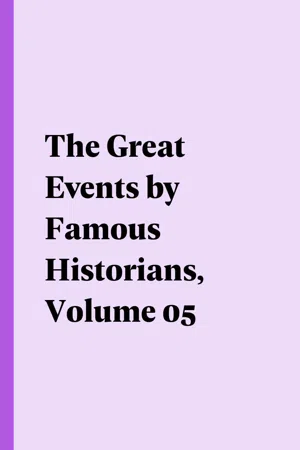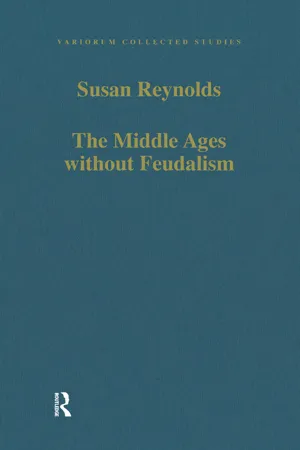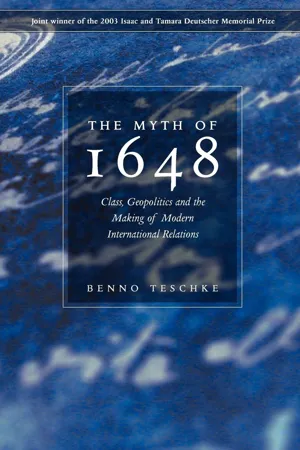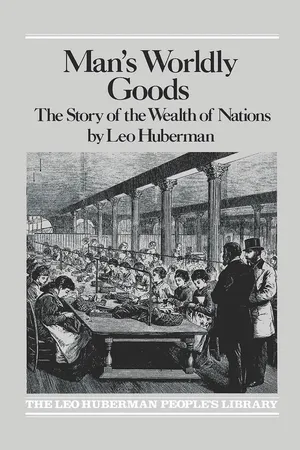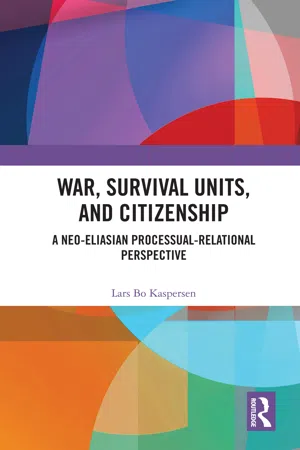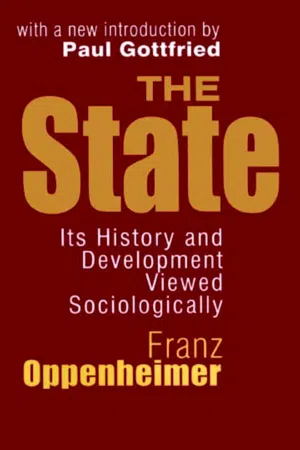History
Western European Feudalism
Western European Feudalism was a social, economic, and political system that emerged in the Middle Ages. It was characterized by a hierarchical structure where land was granted in exchange for loyalty and military service. The system was based on the relationship between lords, vassals, and serfs, and it played a significant role in shaping medieval society and governance.
Written by Perlego with AI-assistance
Related key terms
Related key terms
1 of 4
Related key terms
1 of 3
10 Key excerpts on "Western European Feudalism"
- eBook - ePub
The Great Events by Famous Historians, Volume 05
(From Charlemagne to Frederick Barbarossa)
- (Author)
- 2003(Publication Date)
- Perlego(Publisher)
The gift of land by the king in return for feudal services was called a feudal grant, and the land so given was termed a "feud" or "fief." In the course of time fiefs became hereditary. Lands were also sometimes usurped or otherwise obtained by subjects, who thereby became feudal lords. By a process called "subinfeudation," lands were granted in parcels to other men by those who received them from the king or otherwise, and by these lower landholders to others again; and as the first recipient became the vassal of the king and the suzerain of the man who held next below him, there was created a regular descending scale of such vassalage and suzerainty, in which each man's allegiance was directly due to his feudal lord, and not to the king himself. From the king down to the lowest landholder all were bound together by obligation of service and defence; the lord to protect his vassal, the vassal to do service to his lord.These are the essential features of the social system which, from its early growth under the later Carlovingians in the ninth century, spread over Europe and reached its highest development in the twelfth century. At a time midway between these periods it was carried by the Norman Conquest into England. The history of this system of distinctly Frankish origin—a knowledge of which is absolutely essential to a proper understanding of history and the evolution of our present social system—is told by Stubbs with that discernment and thoroughness of analysis which have given him his rank as one of the few masterly writers in this field.Feudalism had grown up from two great sources—the beneficium, and the practice of commendation—and had been specially fostered on Gallic soil by the existence of a subject population which admitted of any amount of extension in the methods of dependence.The beneficiary system originated partly in gifts of land made by the kings out of their own estates to their kinsmen and servants, with a special undertaking to be faithful; partly in the surrender by land-owners of their estates to churches or powerful men, to be received back again and held by them as tenants for rent or service. By the latter arrangement the weaker man obtained the protection of the stronger, and he who felt himself insecure placed his title under the defence of the church. - eBook - ePub
The Middle Ages without Feudalism
Essays in Criticism and Comparison on the Medieval West
- Susan Reynolds(Author)
- 2018(Publication Date)
- Routledge(Publisher)
23 Since historians do not agree about the phenomena they want to distinguish, or where to draw the line between them, none of these attempts to distinguish the words has eliminated misunderstandings and confusions. None of the terminological distinctions has shaken the old framework in which the interpersonal relations of vassalage and property rights derived from conditional grants are seen as distinguishing features of the society of the European Middle Ages. The framework bulges but for many it still seems strong enough to hold the essential features of medieval society.Most European historians of medieval Europe during the twentieth century concentrated in practice on the history of their own countries, interpreting the evidence of land-holding and political relations within the framework of feudal law and society embodied in something like the Bloch/Weber definition. Some have seen the feudalism of their own area as the most typical or complete, some have stressed its exceptional qualities, but relatively few have been ready to question whether the various phenomena they describe were all part of the same thing – whatever model or type of feudalism they accept or imply. As a result, where evidence of some supposedly feudal phenomenon in their own country is lacking they can either interpolate it from elsewhere or explain its absence as an exception that need not affect the general picture. In England and France historians have used different bits of the Ganshof and Bloch/Weber types to describe, and by implication to explain, quite different situations. Feudalism in England is characterized by a hierarchy of property (though the word tenure, which sounds more feudal, is generally preferred to “property”) and of military service owed from “knights’ fees” – what Bloch called “service tenements.” In England, however, these Blochian characteristics are associated with a strong central power that made noble jurisdiction over peasants relatively unimportant. Feudalism in France, on the other hand, as in Germany, has been seen in terms of fragmented power, with a weak monarchy and a nobility holding “immunities” of jurisdiction over their tenants, while noble obligations to military service have had, in the absence of much evidence, to be assumed. - eBook - ePub
- Neil Faulkner(Author)
- 2018(Publication Date)
- Pluto Press(Publisher)
6
European Feudalism
c . AD 650–1500
English feudal knight. Memorial brass, c . 1400.A world of competing military elites, medieval Europe was exceptionally dynamic, and a new class of farmers, artisans, and traders – ‘the middling sort’ – soon emerged to challenge the rule of feudal lords.Having summarised developments in the rest of the world over a millennium, this chapter turns exclusively to Europe in the same period. Why? Because capitalism and industrial society have their origins in medieval Europe. This great transformation – matched in scale and significance only by the Agricultural Revolution – was pioneered on the north-western fringe of the Eurasian landmass.That this was so was the result of complex interactions between geography, politics, and society over several centuries. It depended on the economic connection between Europeans and the sea; on the social relationships between lords, vassals, and peasants; on the role of merchants, towns, and trade; on the endless wars waged by feudal magnates; on the eternal fragmentation of Europe into a patchwork of warring states; and on the class struggles mounted by ordinary men and women to improve their lot.Understanding these interactions and the series of conjunctures that gave rise to capitalism has been one of the central preoccupations of Marxist historiography for almost two centuries. We must give the problem the attention it deserves.Excursus 2: The Cycles and Arrows of Time In Chapter 2, we discussed ‘how history works’. It may be useful to pause to review some more of the general lessons of the narrative so far.History is formed of cycles and arrows. History’s cycles reflect Nature, a cycle of life, growth, death, and new life. The production cycles of farmers and the reproduction cycles of families are examples. History’s arrows, on the other hand, are the linear progressions of innovation, evolution, and sometimes revolution by which the social world is periodically transformed. - eBook - ePub
Beacon Lights of History, Volume 05
The Middle Ages
- John Lord(Author)
- 2003(Publication Date)
- Perlego(Publisher)
Eadmer's Life of Anselm; Historia Novarum; Sir J. Stephen's Life of Becket, of William of Malmsbury, and of Henry of Huntington; Correspondence of Thomas Becket, with that of Foliot, Bishop of London, and John of Salisbury; Chronicle of Peter of Peterborough; Chronicle of Ralph Niper, and that of Jocelyn of Brakeland; Dugdale's Monasticon; Freeman's Norman Conquest; Michelet's History of France; Green, Hume, Knight, Stubbs, among the English historians; Encyclopaedia Britannica; Hook's Lives of the Archbishops of Canterbury; Lord Littleton on Henry II.; Stanley's Memorials of Canterbury; Milman's Latin Christianity; article by Froude; Morris's Life of Thomas à Becket; J. Craigie Robertson's Life of Thomas Becket.THE FEUDAL SYSTEM.
ABOUT A.D. 800-1300.There is no great character with whom Feudalism is especially identified. It was an institution of the Middle Ages, which grew out of the miseries and robberies that succeeded the fall of the Roman Empire.Before I present the mutual relation between a lord and his vassal, I would call your attention to political anarchies ending in political degradation; to an unformed state of society; to semi-barbarism, with its characteristic vices of plunder, rapine, oppression, and injustice; to wild and violent passions, unchecked by law; to the absence of central power; to the reign of hard and martial nobles; to the miseries of the people, ground down, ignorant, and brutal; to rude agricultural life; to petty wars; to general ignorance, which kept society in darkness and gloom for a thousand years,--all growing out of the eclipse of the old civilization, so that the European nations began a new existence, and toiled in sorrow and fear, with few ameliorations: an iron age, yet an age which was not unfavorable for the development of new virtues and heroic qualities, under the influence of which society emerged from barbarism, with a new foundation for national greatness, and a new material for Christianity and art and literature and science to work upon.Such was the state of society during the existence of feudal institutions,--a period of about five hundred years,--dating from the dismemberment of Charlemagne's empire to the fifteenth century. The era of its greatest power was from the Norman conquest of England to the reign of Edward III. But there was a long and gloomy period before Feudalism ripened into an institution,--from the dissolution of the Roman Empire to the eighth and ninth centuries. I would assign this period as the darkest and the dreariest in the history of Europe since the Roman conquests, for this reason,--that civilization perished without any one to chronicle the changes, or to take notice of the extinction. - eBook - ePub
The Myth of 1648
Class, Geopolitics, and the Making of Modern International Relations
- Benno Teschke(Author)
- 2020(Publication Date)
- Verso(Publisher)
What was the structuring principle of ‘international’ organization in the European Middle Ages? As we saw in chapter 1, Waltz, Krasner, Ruggie, and Spruyt agree on the anarchic nature of the Middle Ages. We can now qualify this assertion and fine-tune the anarchy/hierarchy problematique by historicizing structures of lordship. By focusing on the changing forms of lordship that defined differentiated access to property, we gain a criterion for drawing out differences in the political constitution of medieval geopolitical orders without losing sight of their essential identity. For these alterations in lordly property rights flowed from the social relations that underlay changing geopolitical contexts: feudal empires (650–950), feudal anarchy (950–1150), and the feudal states-system (1150–1450). In other words, the degree to which political powers of extraction were wielded by the landholding class decisively conditioned feudal geopolitical orders. However, while changes in property relations explain differences in structuring principles, these principles do not determine geopolitical behaviour, but only mediate the logic of geopolitical accumulation.1. Banal, Domestic, and Landlordship
The literature distinguishes between three dominant forms of lordship in the European Middle Ages (Duby 1974, 174–7).17 Banal lordship refers to what could most readily claim medieval public authority, namely royal powers of command, taxation, punishment, adjudication, and decree. Being authorized to wield the powers of the ban conferred the most encompassing form of domination and exploitation, constituting what Duby called the ‘master class’ within the medieval ruling class (Duby 1974: 176). Domestic lordship was the prevalent form of domination on the classical bipartite manor of Carolingian times. Here, the lord’s land was divided into a seigneurial demesne tilled by slave labour and specified peasant services, and surrounding peasant plots cultivated independently by tenured peasants. The ‘lord’s men’ had no access to public courts, nor did they have to pay public taxes. They were exclusively subject to manorial control (Bloch 1966a: 70). Landlordship - eBook - ePub
Beacon Lights of History, Volume 3 part 1
The Middle Ages
- John Lord(Author)
- 1998(Publication Date)
- Perlego(Publisher)
Eadmer's Life of Anselm; Historia Novarum; Sir J. Stephen's Life of Becket, of William of Malmsbury, and of Henry of Huntington; Correspondence of Thomas Becket, with that of Foliot, Bishop of London, and John of Salisbury; Chronicle of Peter of Peterborough; Chronicle of Ralph Niper, and that of Jocelyn of Brakeland; Dugdale's Monasticon; Freeman's Norman Conquest; Michelet's History of France; Green, Hume, Knight, Stubbs, among the English historians; Encyclopaedia Britannica; Hook's Lives of the Archbishops of Canterbury; Lord Littleton on Henry II.; Stanley's Memorials of Canterbury; Milman's Latin christianity; article by Froude; Morris's Life of Thomas a Becket; J. Craigie Robertson's Life of Thomas Becket.THE FEUDAL SYSTEM.
About A. D. 800-1300.There is no great character with whom Feudalism is especially identified. It was an institution of the Middle Ages, which grew out of the miseries and robberies that succeeded the fall of the Roman Empire.Before I present the mutual relation between a lord and his vassal, I would call your attention to political anarchies ending in political degradation; to an unformed state of society; to semi- barbarism, with its characteristic vices of plunder, rapine, oppression, and injustice; to wild and violent passions, unchecked by law; to the absence of central power; to the reign of hard and martial nobles; to the miseries of the people, ground down, ignorant, and brutal; to rude agricultural life; to petty wars; to general ignorance, which kept society in darkness and gloom for a thousand years,—all growing out of the eclipse of the old civilization, so that the European nations began a new existence, and toiled in sorrow and fear, with few ameliorations: an iron age, yet an age which was not unfavorable for the development of new virtues and heroic qualities, under the influence of which society emerged from barbarism, with a new foundation for national greatness, and a new material for Christianity and art and literature and science to work upon.Such was the state of society during the existence of feudal institutions,—a period of about five hundred years,—dating from the dismemberment of Charlemagne's empire to the fifteenth century. The era of its greatest power was from the Norman conquest of England to the reign of Edward III. But there was a long and gloomy period before Feudalism ripened into an institution,—from the dissolution of the Roman Empire to the eighth and ninth centuries. I would assign this period as the darkest and the dreariest in the history of Europe since the Roman conquests, for this reason, that civilization perished without any one to chronicle the changes, or to take notice of the extinction. - eBook - ePub
- Leo Huberman(Author)
- 1936(Publication Date)
- Monthly Review Press(Publisher)
This does not mean, of course, that this particular piece of land was all that Alan, or William, or Gilbert, etc., “held.” Not at all. The manor itself might be the only property a knight possessed, or it might be one small part of a great domain which was itself a part of a fief, or huge grant of land. Some nobles possessed a few manors, others possessed several domains, and others possessed a number of fiefs scattered in different places. In England, for example, one rich baron owned estates which were made up of over 790 holdings. In Italy a few great lords owned over 10,000 manors. Of course the king, who nominally was the owner of all the land, owned vast estates spread all over the country. The people who held directly from the king, whether they were nobles or just ordinary freemen, were called tenants-in-chief.As time went on, the larger estates tended to be broken up into smaller holdings held by more and more nobles of one rank or another. Why? Simply because every lord found it necessary to attach to himself as many vassals as he could, and the only way to do that was to give away part of his land.Nowadays, land, factories, mills, mines, railways, boats, and machinery of all kinds are necessary to produce the goods that you and I use, and we call a man wealthy or not, depending on how much of these he owns. But in feudal times, just the land produced practically all the goods that were needed and so land and land alone was the key to a man’s fortune. The measure of a man’s wealth was determined by only one thing—the amount of land he possessed. Naturally there was a continual scramble for the land, so you won’t be surprised to learn that the feudal period was a warring period. In order to win the wars, the trick was to get as many people on your side as possible, and the way to do that was to pay fighters to help you. You got them to make certain payments and promise to help you when you needed it, and in return you gave them a grant of land. Thus, from an old French document of the year 1200, we learn that, “I, Thiebault, count palatine of Troyes, make known to those present and to come, that I have given in fee to Jocelyn d’Avalon and his heirs the manor which is called Gillencourt.… The same Jocelyn, moreover, on account of this has become my liegeman.” - eBook - ePub
War, Survival Units, and Citizenship
A Neo-Eliasian Processual-Relational Perspective
- Lars Kaspersen(Author)
- 2020(Publication Date)
- Routledge(Publisher)
Ständestaat. However, that sort of more detailed exposition is beyond the scope of this book.2 We have to keep in mind that clearly demarcated territories did not exist. Moreover, it would not be entirely correct to call all of the figurational processes “English” that unfolded within the area that later became England or Britain. Again, this is a “retrospective” feature because no one could foresee that that land would later become England or Britain, nor could anyone predict the emergence of a fixed border between England and France.3 Here we describe the “English” process, but a similar process took place in “France” shortly afterward.4 The process of monopolization in France and England is analyzed by Elias (2012a [1939], pp. 311–323) and Strayer and Munro (1959, pp. 277–305).5 It is beyond the scope of this study to go into detail about the complex pattern of privileges and obligations in the feudal relationships. It is worth mentioning that it is a contested area among historians, and one of the disputed issues concerns the concepts. Most of the concepts used to analyze feudalism were developed in a postfeudal context (for a detailed analysis of the terminology and main concepts used to analyze the period from 800 to 1300 in France, England, and Germany, see Reynolds [1994]).6 For further reading on the guild and its particular form of rights and obligations, see Gierke (1987, 1990, especially chapters 3–5); Black (1984, 1992, especially chapter 1).Passage contains an image
Chapter 5
Centripetal forces
Two steps forward, one step back, 1300–1500
In this chapter, we move on to an examination of the European figuration of survival units from around 1300 to 1500. The character of the struggle for recognition began to change, not least because the feudal military structure began to alter. The first section concerns the development of towns and estates (assemblies), which were crucial to the rise of a new form of survival unit, the Ständestaat - eBook - ePub
The History of Democracy
A Marxist Interpretation
- Brian S. Roper(Author)
- 2012(Publication Date)
- Pluto Press(Publisher)
being the post-Roman province with the least peasant subjection, in 700, to the land where peasant subjection was the completest and most totalizing in the whole of Europe, by as early as 900 in much of the country, and by the eleventh century at the latest elsewhere. The lordships of France based on private justice did not develop in England but they hardly needed to; peasants were already entirely subject to lords tenurially, and many were unfree and thus had not rights to public justice either.(Wickham, 2009: 469)This development at the very beginning of feudalism in England explains why ‘it became the European country where aristocratic dominance, based on property rights, was most complete, while also being the post-Carolingian country where kings maintained most fully their control over political structures, both traditional (assemblies, Armies) and new (oaths, taxation)’ (Wickham, 2009: 471).THE CRISIS OF FEUDALISM AND THE EMERGENCE OF ABSOLUTISM IN FRANCE AND CAPITALISM IN ENGLAND The crisis of feudalismAs mentioned above, throughout most of the tenth to thirteenth centuries the feudal societies of Western Europe grew strongly both economically and demographically. By the end of the thirteenth century population growth, urbanisation, aristocratic consumption and spending on warfare, and the growing sophistication and size of royal administrations, had not been sufficiently matched by the growth of agricultural productivity and output. Indeed, agricultural output had started to decline and there were mounting signs of crisis even before poor crops resulting from adverse climatic conditions led to famine in much of Western Europe from 1315 to 1317 (Hilton, 1985: 131; Nicholas, 1992: 401–5). With malnutrition widespread the population was vulnerable to the epidemics that swept across Europe from the mid-fourteenth to the mid-fifteenth centuries. The worst of these was the Black Death, which ‘had spread through central France by the early summer of 1348, to southern England by that winter, and to the rest of England and the Low Countries by the end of 1349. It then moved northeast into Scandinavia and Slavic Europe’ (Nicholas, 1992: 404). Most regions lost from a quarter to a third of their populations, the cities generally lost more than this, and there were further outbreaks of bubonic plague ‘in 1358, 1361, one in 1368–69 that may have been more severe in the Low Countries than that of 1348–49 and another in 1374–75 that was especially virulent in England’ where as much as half the population may have perished (Nicholas, 1992: 404). From the mid-fourteenth to the mid-fifteenth century, ‘a hellish cycle’ unfolded in which the growth of population and output during the preceding centuries was followed by ‘ecological collapse and mass starvation’ (Callinicos, 1987: 165). - eBook - ePub
The State
Its History and Development Viewed Sociologically
- Franz Oppenheimer(Author)
- 2018(Publication Date)
- Routledge(Publisher)
CHAPTER VThe Development of the Feudal State
(A) THE GENESIS OF LANDED PROPERTY
WE now return, as stated above, to that point where the primitive feudal State gave rise to the city State as an offshoot, to follow the upward growth of the main branch. As the destiny of the city State was determined by the agglomeration of that form of wealth about which the State swung in its orbit, so the fate of the territorial State is conditioned by that agglomeration of wealth which in turn Controls its orbit, the ownership of landed property.In the preceding, we followed the economic differentiation in the case of the shepherd tribes, and showed that even here the law of the agglomeration about existing nuclei of wealth begins to assert its efficacy, as soon as the political means comes into play, be it in the form of wars for booty or still more in the form of slavery. We saw that the tribe had differentiated nobles and common freemen, beneath whom slaves, being without any political rights, are subordinated as a third class. This differentiation of wealth is introduced into the primitive state, and sharpens very markedly the contrast of social rank. It becomes still more accentuated by settlement, whereby private ownership in lands is created. Doubtless there existed even at the time when the primitive feudal state came into being, great differences in the amount of lands possessed by individuals, especially if within the tribe of herdsmen the separation had been strongly marked between the prince-like owners of large herds and many slaves, and the poorer common freemen. These princes occupy more land than do the small freemen.At first, this happens quite harmlessly, and without a trace of any consciousness of the fact that extended possession of land will become the means of a considerable increase of social power and of wealth. Of this, there is at this time no question, since at this stage the common freemen would have been powerful enough to prevent the formation of extended landed estates had they known that it would eventually do them harm. But no one could have foreseen this possibility. Lands, in the condition in which we are observing them, have no value. For that reason the object and the spoils of the contest were not the possession of lands, but of the Und and its peasants, the latter being bound to the soil (glebœ adscripti
Index pages curate the most relevant extracts from our library of academic textbooks. They’ve been created using an in-house natural language model (NLM), each adding context and meaning to key research topics.
Explore more topic indexes
Explore more topic indexes
1 of 6
Explore more topic indexes
1 of 4
